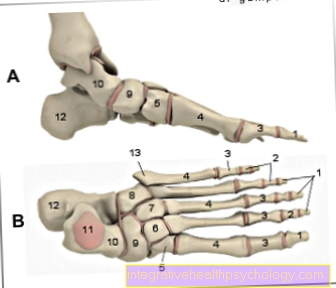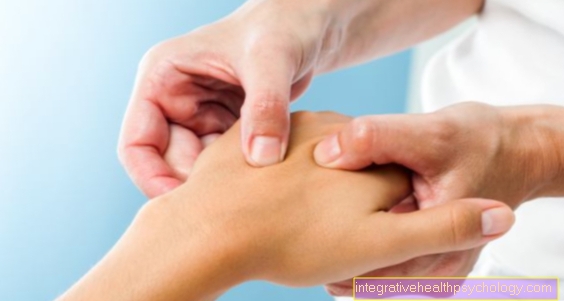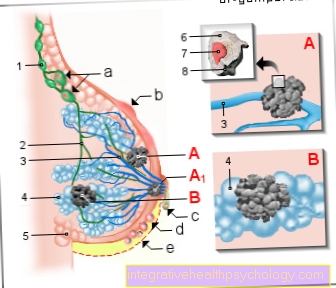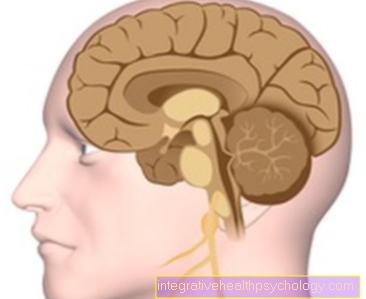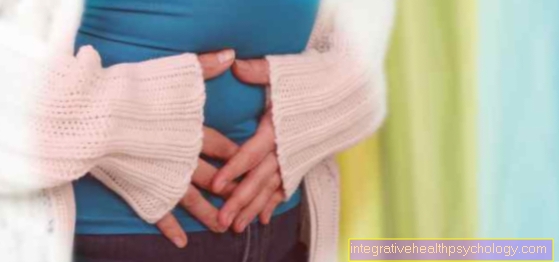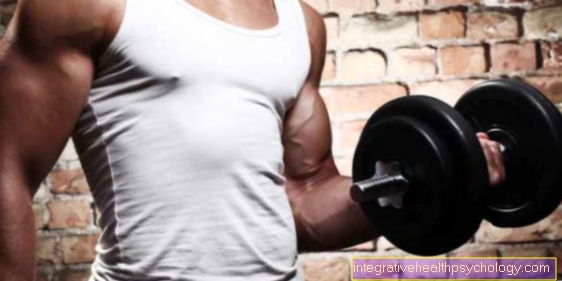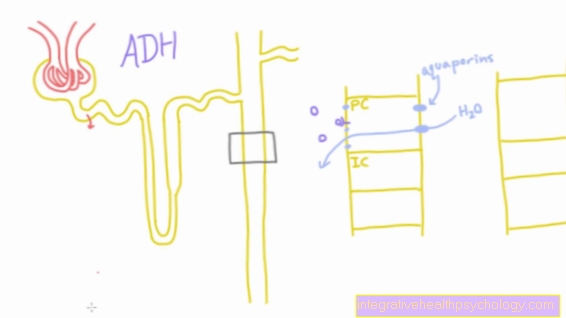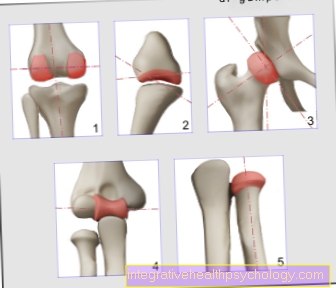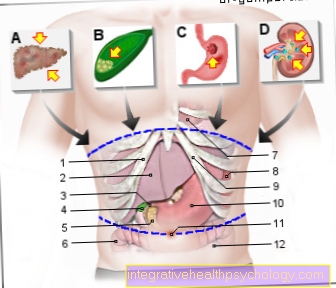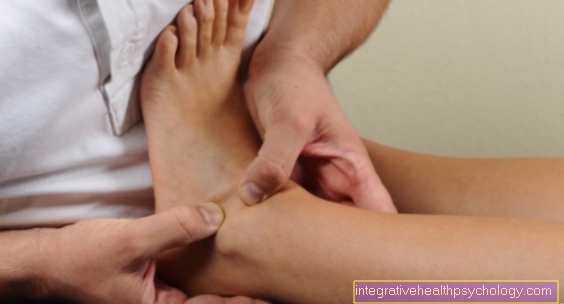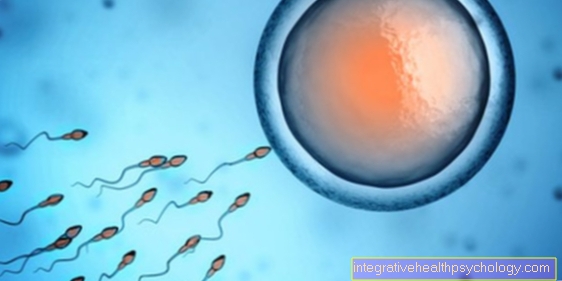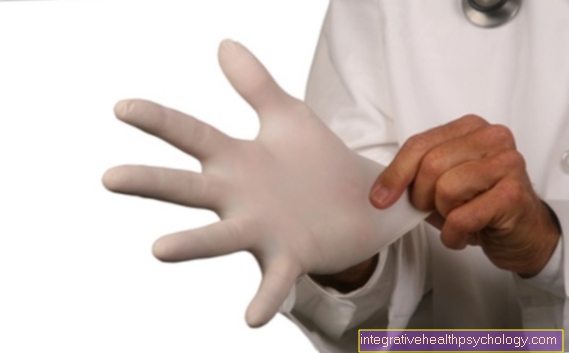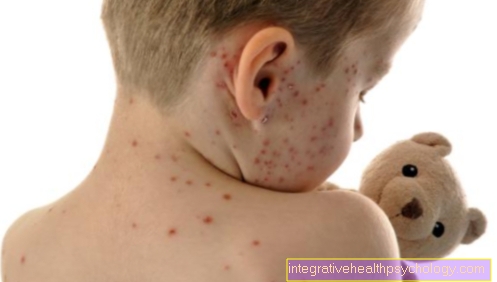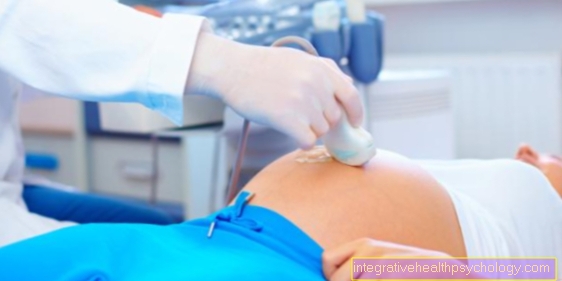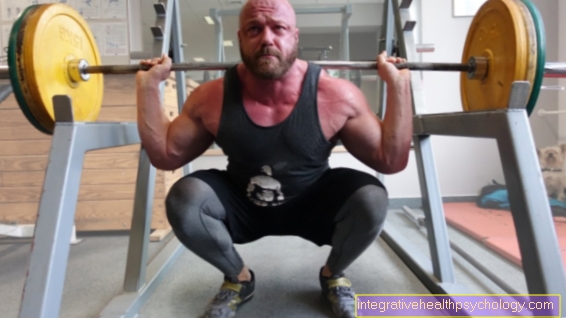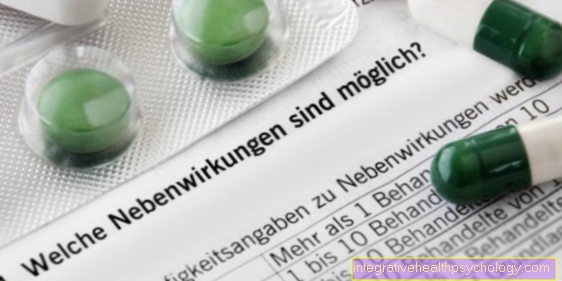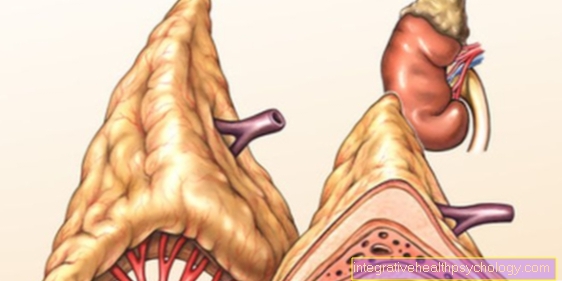The male breast
introduction
The male breast (Mamma masculina) is basically designed in the same way as the female breast. In contrast to the female form, the male breast is not a secondary gender characteristic.

Structure of the male breast
Due to a lack of hormonal processes, the male breast does not develop further, but has no greater function than the female breast. Men also have mammary glands. The gland body is approx. 1.5 cm wide and 0.5 cm thick.
This is also one of the reasons why breast cancer affects by far not only women but also men. However, the risk of breast cancer is significantly lower than that of women. Only about every hundredth breast cancer affects the male breast. Warning signs can be gynecomastia in the form of a swelling or lump of the breast on one side.
Hormonal disorders or the use of doping drugs or hormone drugs may lead to the development of a female breast, even in men. The mammary gland is not visible under the skin of the male or female breast. There are about 10 mammary glands in each female breast, and fewer in the male breast. Topographically, the mammary gland is located slightly below the skin on the large pectoral muscle and is enclosed by fat and connective tissue. The pectoralis major muscle, the pectoralis major muscle, is the actual factor that defines a male breast. If it is built up through regular and targeted strength training, one recognizes a pronounced chest shape in men. On the muscular level, the aforementioned pectoralis major muscle should be mentioned here. It is considered the great pectoral muscle and is divided into 3 parts:
-
Pars clavicularis (clavicle part)
-
Pars sternocostalis (sternum-rib part)
-
Pars abdominalis (abdominal part)
It thus covers the entire rib area. This muscle has its origins according to the name of its parts.
The pars clavicularis has its origin in the middle half of the collarbone.
Pars sternocostalis on the middle part of the sternum and on the cartilages of the 2nd-6th centuries. Rib. The pars abdominalis on the anterior part of the tendon plate of the rectus abdominis muscle.
Please also read our topic on this "Why do men have nipples?"
Illustration of the pectoral muscle culture
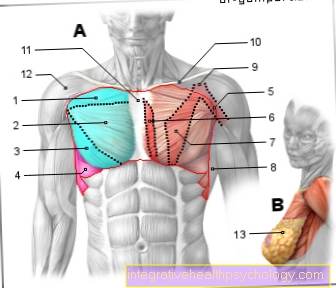
Chest muscles
- Pectoralis major
(Collarbone - proportion) -
Muscle pectoralis major,
Pars clavicularis - Pectoralis major
(Sternum - ribs - area) -
Muscle pectoralis major,
Pars sternocostalis - Pectoralis major
(Abdominal area) -
Muscle pectoralis major,
Pars abdominalis - Anterior saw muscle -
Muscle serratus anterior - Raven beak
Upper arm muscle
(second layer) -
Muscle coracobrachialis - Sternum muscle (often absent) -
Sternalis muscle - Small pectoral muscle
(second layer) -
Muscle pectoralis minor - Broad back muscle -
Latissimus dorsi muscle - Raven beak process -
Coracoid process - Collarbone -
Clavicle - Sternum - sternum
- Deltoid -
Muscle deltoideus - Fat and connective tissue,
as well as glandular lobes -
Glandula mammaria
You can find an overview of all Dr-Gumpert images at: medical illustrations
Why do men have nipples?
At the beginning of embryonic development, all embryos are the same and no distinction can be made between male and female. The Y chromosome of the male fetus does not become active until the 8th week and causes the testicles to develop and differentiate between the sexes. By then, however, the milk bars, which are seen as a preliminary stage to the nipples, are already present.
That is why men are also equipped with nipples, although they have no functional value for men. Due to the testosterone produced by the testes and the lack of female hormones, breasts do not develop during puberty.
Read more on this topic at: Why do men have nipples?
The male mammary gland
The male mammary glands are located below the nipples and are inferior to the female mammary glands in size and number, which can be explained by the hormonal makeup of the man.
Only female hormones such as estrogen stimulate the mammary gland tissue to grow. Lactation, i.e. the production of milk, does not occur in males, as high concentrations of the hormone oxytocin are required for this. If the male mammary glands are enlarged, it is called gynecomastia.
Breast cancer in men
The topic of breast cancer is very present today and there is a lot of prevention, but always related to the female gender. In fact, there are also cases of breast cancer in men, although these occur much less frequently than in women. According to statistics, 1% of all new cases affect men.
For more information see also: Breast cancer in men
The causes of breast cancer in men are, on the one hand, a genetic predisposition, which often leads to mutations in the mammary glands. On the other hand, a disturbed hormonal balance can increase the risk. Obesity and liver disease cause increased levels of estrogen, which stimulate breast cell growth. Lumps and hardening are signs and should be clarified with a doctor
Read more on the topic: Breast lumps in men or how to recognize breast cancer in men
Gynecomastia in men
Gynecomastia is an enlargement of the male mammary gland.
A distinction is made between real and fake gynecomastia.
While the fake form is enlarged by fat deposits and usually occurs in overweight people, the real form is characterized by the growth of breast tissue.
The trigger for real gynecomastia is a derailed hormone balance in favor of female sex hormones.
Further sub-forms can be distinguished. The most common form occurs in boys during puberty, which is why it is called puberty gynecomastia.
In this phase of life, the many changes in the body can lead to an increased production of estradiol. This hormone belongs to the group of estrogens and is considered to be the cause of this form of gynecomastia. The elderly gynecomastia and pseudogynecomastia are also known.
Both forms are based on a changing fat tissue mass / body tissue mass ratio. Fat cells have the ability to convert male sex hormones into estrogens, which also increases the body's estrogen levels and thus stimulates breast growth.
In the treatment of gynecomastia, an attempt is first made to adjust the hormonal balance again. If this is unsuccessful, there is the possibility of surgical intervention.
Read more on the topic: Gynecomastia - benign enlargement of the mammary gland in men
Chest pain
Chest pain in men is often caused by swelling of the chest. Technically, one speaks here of gynecomastia. However, this does not have to be accompanied by pain or feelings of tension in every case. A distinction is made between a natural and pathological form of gynecomastia. The so-called "male breast" is now a well-known and widespread phenomenon. It is a problem especially with young adolescents, as it is often used as a basis for “bullying” among young people. The basis for gynecomastia is based on the hormone estrogen, which is also produced in small quantities in men. However, this hormone also stimulates the mammary gland and leads to growth.However, painful swelling of the chest can also be caused by medication or hormone treatments with testosterone. Drugs that can cause gynecomastia include highly active antiretroviral therapeutics for HIV infection. Also the sedative diazepam or certain antibiotics. In addition, heart drugs such as digitalis preparations or calcium antagonists are considered risk factors. Intoxicants such as alcohol, amphetamines, marijuana and heroin are also considered triggers.
Furthermore, it remains to be said that chest pain and painful breasts are often difficult to differentiate from one another. Examples are Tietze syndrome - a swelling at the base of the 2nd and 3rd ribs of the sternum -, changes in the thoracic or cervical spine, pleurisy or pneumonia, serious heart problems such as angina pectoris, myocardial infarction / cardiac arrhythmias, diseases of the thyroid gland , as well as the arteries, the esophagus, the stomach, and many others.
Please also read our article on this Swelling of the chest.
Tightening of the male breast
A tightening of the male breast is usually achieved through liposuction if it is a "fake" gynecomastia, i.e. pure fat accumulation in obese patients. This is usually a small surgical procedure in which fat cells under the skin are suctioned off with fine cannulas. “Real” gynecomastia, on the other hand, should be treated by surgical removal of the gland. In the case of pronounced findings of gynecomastia and lipomastia as well as possible relaxation, plastic surgery offers various reduction plastics.
A sensible alternative to counteracting sagging connective tissue in the chest is targeted chest training in the form of strength training. Push-ups and chest presses with dumbbells turned out to be particularly effective. Push-ups train both the upper and lower chest muscles. Diet is also a crucial factor. It has been scientifically proven several times that the intake of toxins in the form of smoking has negative effects on tissue elasticity. Because the pollutants contained in tobacco smoke inhibit the release of the structural protein elastin, which among other things is responsible for the elasticity of the skin and connective tissue. In addition, the inhibition of the protein is not only noticeable on the chest, but also on the skin all over the body. The aging process of the skin is accelerated. In addition to these factors, it is also possible to use natural cosmetics to help. The main mode of action is the protection against UV rays, which release so-called "free radicals". These cause damage to the connective tissue, which leads to a loss of elasticity.
Read more on the topic: Connective tissue of the chest

